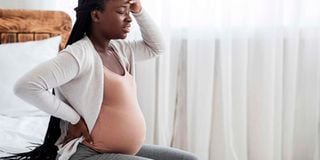Pregnancy and back pain

What you need to know:
- As the tortured skeletal support struggles to carry the ever-increasing pregnancy weight, there is a disproportionate increase in the burden borne across some joints, with an exaggerated forward curve of the lower back spine (lumbar lordosis) forcing the neck to also curve forward and shoulders to droop.
- All this is in an effort to avoid toppling forward. The excessive stretch of the abdominal muscles causes them to weaken and separate, further worsening the posture.
Gratia* walked into the office appearing to be in great discomfort. She made a bee-line for the examination couch and settled herself in. Her husband followed, wheeling in their angelic three-month-old daughter in a cute animal-print stroller. The baby was asleep and daddy was exhausted.
Gratia lurched into a tirade. She was at her wits’ end. She wanted her back pain gone. She did not care what it took; she just wanted it to stop! Her life had ground to a halt. She had a newborn baby but she wasn’t enjoying motherhood because she was incapacitated by pain.
Gratia and her husband Saul* met in campus and started dating. They were both political science students who loved the outdoors. They spent their free time hiking, mountain climbing, and riding their motorbikes through weird isolated scenic roads in the wild north and the breathtaking Rift Valley.
In their mid-20s, they decided to slow down and start a family. In just under three years, they had two adorable sons who grounded them fully. I met the couple for the first time in their early 40s. They were 12 weeks pregnant, almost a decade and a half since they last had a baby. They clearly hadn’t lost their spunk, only that instead of riding off into the sunset on their roaring bikes, they decided to make a baby!
Like most couples having their third baby, the laissez-faire attitude towards pregnancy and childbirth was fully switched on! I constantly scolded Gratia for forgetting to take her pregnancy supplements; eat a regular, balanced diet and exercise. Thankfully, she worked from home and was able to drink lots of water, take multiple breaks from her computer and walk around, which was good for her circulation and reduction of risk for deep vein thrombosis.
The little one kept growing rather beautifully and at 20 weeks, the anxious couple had an obstetric ultrasound confirming that their daily prayers to the good Lord above had paid off and they were going to have a daughter. With their wish granted, they took off for a celebratory weekend! I made them promise not to ride any bikes!
What we did not predict was that this was going to be the last holiday the two would have in a while. A month later, Gratia started complaining of lower back pain. At first, it was after prolonged durations of sitting at her desk, relieved by walking about and stretching. We worked on improving her posture, taking more frequent breaks and avoiding working on her laptop while in bed.
Gratia’s complaints were not uncommon — more likely to occur in women with preexisting back pain, back pain in a previous pregnancy, multiple babies and those who have a high body mass index. On average, a mum will gain 10 to 15 kilos over the 40-week pregnancy period. This weight is attributed to the growing baby, the expanding uterus, the amniotic fluid, the expanding blood volume, the increased breast tissue and the increased body fat deposition.
The pregnancy hormones; relaxin, oestrogen and progesterone, cause relaxation of the joints of bones all over the body, but most noticeably in the bones that support posture, losing the capacity of the bones and joints to maintain an appropriate position, straining the axial skeleton and pelvis. Combined with the increasing weight, the mum undergoes a shift in her centre of gravity.
As the tortured skeletal support struggles to carry the ever-increasing pregnancy weight, there is a disproportionate increase in the burden borne across some joints, with an exaggerated forward curve of the lower back spine (lumbar lordosis) forcing the neck to also curve forward and shoulders to droop. All this is in an effort to avoid toppling forward. The excessive stretch of the abdominal muscles causes them to weaken and separate, further worsening the posture.
As the lumbar spine strains due to the exaggerated lordosis, the back muscles also strain, trying to hold the spine in place. The same happens to knees, hips and sacroiliac joints (the joints connecting the last part of the spine to the circular bones of the pelvis). The mother’s gait is automatically compromised, resulting in the classical ‘duck walk’ of late pregnancy.
The end result is wide, increasingly mobile joints; nature’s way of trying to ensure the pelvis can expand its circumference a little wider to allow the baby through during delivery, changes that can persist after delivery in some women. In addition, with advancing pregnancy, there is a lot of fluid retention in the body within the tissues. This may lead to the unfortunate compression of important structures such as nerves, causing intense pain.
Gratia experienced all these symptoms and then some. The pain relief brought about by the simple interventions helped for only a little while before progressing to a constant, nagging pain that would hinder normal function, keeping her up on some nights. She required treatment by the time she was 28 weeks pregnant. Yet she adamantly refused to see an orthopaedic surgeon, putting it off until after delivery.
Different patients respond differently to treatment modalities but overall, the aim is to control pain and discomfort and prevent the onset of long-standing complications. Low-heeled (not flat) shoes with good arch support are recommended by the American College of Obstetricians and Gynaecologists . The mother should avoid lifting heavy objects, sitting for long periods, sleep on a firm mattress, have good back support when seated and sleep on the side with pillows between the knees for support. Cold or hot compresses, massage, exercise, physiotherapy and hydrotherapy are beneficial.
A combination of the recommended treatments tided Gratia over during pregnancy. She opted for pregnancy yoga instead of physiotherapy and she was able to make it to delivery. Unfortunately, Gratia fell into the 20 per cent category of mothers whose pain won’t go away even after delivery, persisting for months to years. The constant discomfort also hindered activity, resulting in unprecedented postpartum weight gain, which made everything worse for her back.
Gratia was transferred to the care of an orthopedic surgeon and with the help of a team of specialists, she managed to get back to full function in a year. She swore off bearing any more children!





